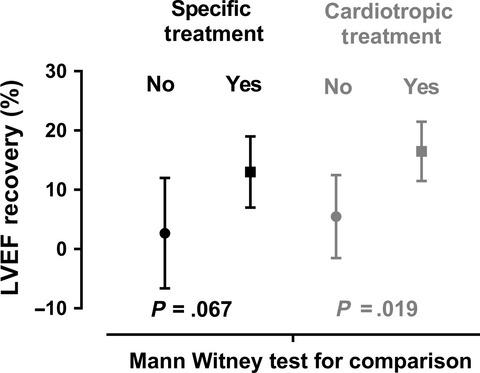当前位置:
X-MOL 学术
›
Cancer Med.
›
论文详情
Our official English website, www.x-mol.net, welcomes your
feedback! (Note: you will need to create a separate account there.)
Left ventricular ejection fraction decrease related to BRAF and/or MEK inhibitors in metastatic melanoma patients: A retrospective analysis.
Cancer Medicine ( IF 2.9 ) Pub Date : 2020-02-14 , DOI: 10.1002/cam4.2922 Mathilde Berger 1 , Mona Amini-Adlé 1 , Delphine Maucort-Boulch 2, 3 , Philip Robinson 4 , Luc Thomas 1, 5 , Stéphane Dalle 1, 5 , Pierre-Yves Courand 6, 7
Cancer Medicine ( IF 2.9 ) Pub Date : 2020-02-14 , DOI: 10.1002/cam4.2922 Mathilde Berger 1 , Mona Amini-Adlé 1 , Delphine Maucort-Boulch 2, 3 , Philip Robinson 4 , Luc Thomas 1, 5 , Stéphane Dalle 1, 5 , Pierre-Yves Courand 6, 7
Affiliation

|
BRAF and MEKis have revolutionized the management of BRAFV600 -mutated melanoma patients. Left ventricular ejection fraction decrease (LVEF-D) related to these treatments has not been thoroughly evaluated to date. The main objective of this study was to describe characteristics of LVEF-D in melanoma patients treated with BRAF and/or MEKis. Metastatic melanoma patients treated with BRAF and/or MEKis between March 1, 2012 and May 18, 2018 were included retrospectively (Lyon Sud University Hospital, Hospices Civils de Lyon). LVEF-D was defined as a reduction in LVEF ≥10% from baseline to a value <55%; normalization was defined as a value ≥55%. Among the 88 patients included, 12 (13.6%) experienced a LVEF-D, including 10 grade 2 and 2 grade 3. The median onset of which was 11 months (IQR [3-21]). No patient previously treated with beta-blockers (n = 12) experienced a LVEF-D. Analysis of laboratory parameters, electrocardiogram, and transthoracic echocardiography during the follow-up did not find any predictive marker of LVEF-D. All patients who benefited from a specific treatment of LVEF-D had a normalization of LVEF at the end of follow-up. LVEF recovery was significantly better for patients treated with angiotensin converting enzyme inhibitors and beta-blockers than those who did not (P = .019). Ophthalmological adverse events were significantly more frequent in patients who experienced a LVEF-D (P = .006) and the latter did not influence overall-survival (P = .117) or progression-free-survival (P = .297). LVEF-D is a common and easily manageable adverse event due to BRAF and MEKis. Its association with ocular toxicity suggests a close ophthalmological monitoring when LVEF-D occurs.
中文翻译:

转移性黑色素瘤患者与BRAF和/或MEK抑制剂相关的左心室射血分数降低:一项回顾性分析。
BRAF和MEKis彻底改变了BRAFV600突变的黑色素瘤患者的治疗方法。迄今为止,尚未彻底评估与这些治疗有关的左心室射血分数降低(LVEF-D)。这项研究的主要目的是描述接受BRAF和/或MEKis治疗的黑色素瘤患者的LVEF-D特征。回顾性纳入2012年3月1日至2018年5月18日期间接受BRAF和/或MEKis治疗的转移性黑色素瘤患者(里昂市南里昂大学医院)。LVEF-D被定义为LVEF从基线降低≥10%至值<55%;标准化定义为值≥55%。在88名患者中,有12名(13.6%)经历了LVEF-D,包括10级2级和2级3级。中位发作为11个月(IQR [3-21])。以前没有接受过β受体阻滞剂治疗的患者(n = 12)没有LVEF-D。随访期间分析实验室参数,心电图和经胸超声心动图均未发现LVEF-D的任何预测指标。在随访结束时,所有受益于LVEF-D特异性治疗的患者均已恢复LVEF。与未接受血管紧张素转换酶抑制剂和β-受体阻滞剂治疗的患者相比,LVEF恢复显着更好(P = .019)。经历LVEF-D(P = .006)的患者眼科不良事件的发生率明显更高,而后者不影响总体生存(P = .117)或无进展生存(P = .297)。由于BRAF和MEKis,LVEF-D是常见且易于控制的不良事件。
更新日期:2020-02-14
中文翻译:

转移性黑色素瘤患者与BRAF和/或MEK抑制剂相关的左心室射血分数降低:一项回顾性分析。
BRAF和MEKis彻底改变了BRAFV600突变的黑色素瘤患者的治疗方法。迄今为止,尚未彻底评估与这些治疗有关的左心室射血分数降低(LVEF-D)。这项研究的主要目的是描述接受BRAF和/或MEKis治疗的黑色素瘤患者的LVEF-D特征。回顾性纳入2012年3月1日至2018年5月18日期间接受BRAF和/或MEKis治疗的转移性黑色素瘤患者(里昂市南里昂大学医院)。LVEF-D被定义为LVEF从基线降低≥10%至值<55%;标准化定义为值≥55%。在88名患者中,有12名(13.6%)经历了LVEF-D,包括10级2级和2级3级。中位发作为11个月(IQR [3-21])。以前没有接受过β受体阻滞剂治疗的患者(n = 12)没有LVEF-D。随访期间分析实验室参数,心电图和经胸超声心动图均未发现LVEF-D的任何预测指标。在随访结束时,所有受益于LVEF-D特异性治疗的患者均已恢复LVEF。与未接受血管紧张素转换酶抑制剂和β-受体阻滞剂治疗的患者相比,LVEF恢复显着更好(P = .019)。经历LVEF-D(P = .006)的患者眼科不良事件的发生率明显更高,而后者不影响总体生存(P = .117)或无进展生存(P = .297)。由于BRAF和MEKis,LVEF-D是常见且易于控制的不良事件。










































 京公网安备 11010802027423号
京公网安备 11010802027423号